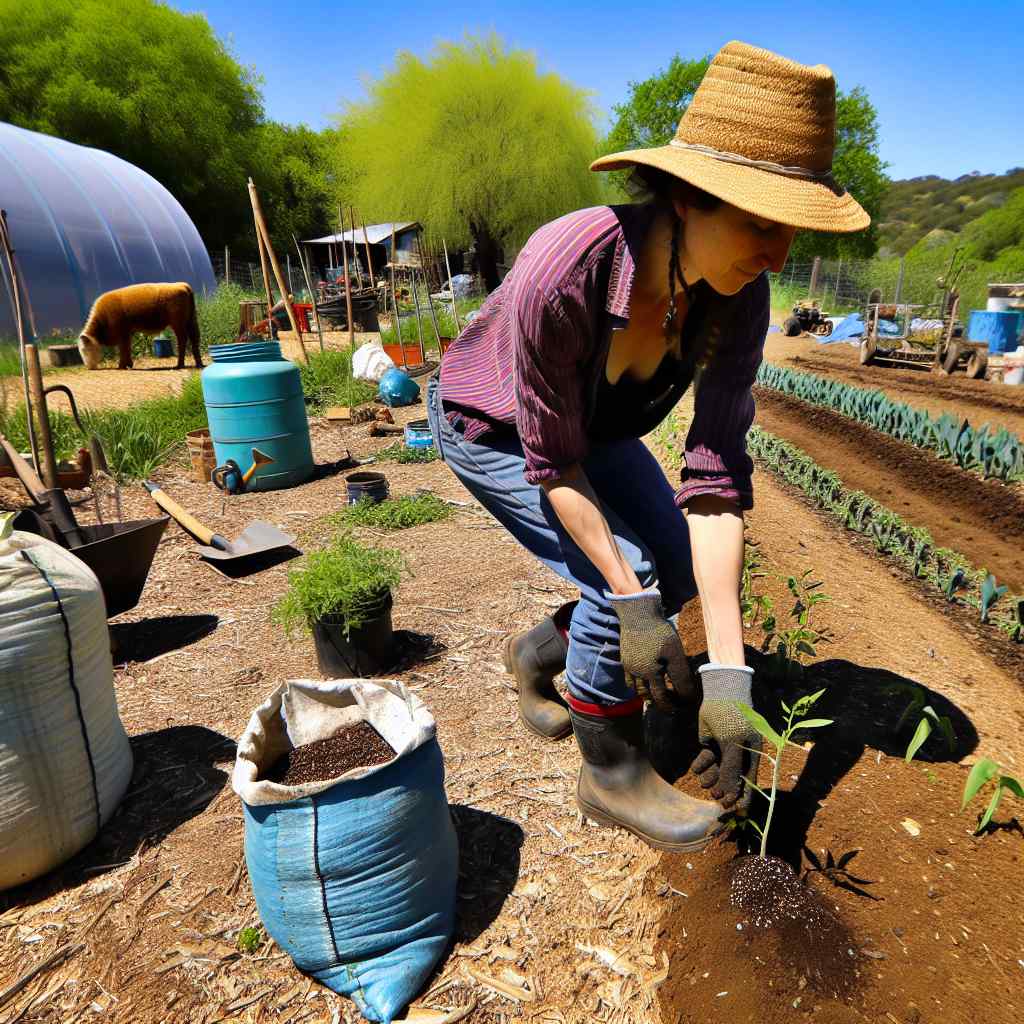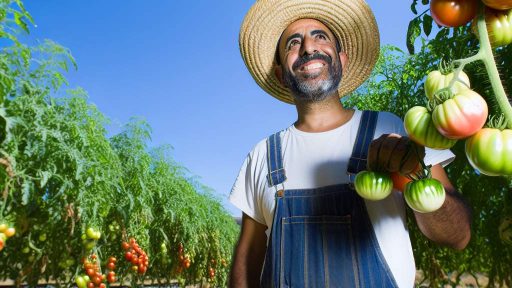Introduction to Permaculture
Definitions of Permaculture
Permaculture is a design philosophy that aims to create sustainable and self-sufficient agricultural systems.
It blends ecology, landscape design, and environmental science.
This approach integrates various agricultural practices to mimic natural ecosystems.
In essence, permaculture promotes regenerative practices that benefit the land.
Core Principles of Permaculture
Permaculture is guided by several core principles that shape its practices.
First, observe and interact with the environment.
Observation helps identify the unique needs of a landscape.
Next, catch and store energy for later use.
This principle encourages using resources efficiently.
Another important principle is to obtain a yield.
This principle emphasizes producing food and other resources sustainably.
Designing for Sustainability
Effective permaculture designs focus on creating habitats that are productive and resilient.
This involves analyzing the space and its natural characteristics.
Utilizing zones and sectors optimizes land use and resource management.
Additionally, diversity plays a crucial role in a resilient ecosystem.
Transform Your Agribusiness
Unlock your farm's potential with expert advice tailored to your needs. Get actionable steps that drive real results.
Get StartedA variety of plants and animals enhances stability and sustainability.
Community Involvement
Permaculture encourages community engagement and collaboration.
Working together fosters knowledge sharing and collective resilience.
Cooperative efforts can enhance local food systems.
Moreover, community support can amplify permaculture practices.
Educating others about permaculture enriches community ties.
Holistic Approach to Agricultural Design
Permaculture promotes a holistic approach to problem-solving in agricultural practices.
This means considering all elements within the system and their relationships.
For instance, understanding how water, soil, and plants interact is crucial.
This interconnected mindset leads to more sustainable outcomes.
By acknowledging the connections, we can create more resilient ecosystems.
The Importance of Resilient Agricultural Ecosystems in the Face of Climate Change
Adapting to Changing Conditions
Agricultural ecosystems must adapt to changing climate conditions.
This adaptation improves crop resilience and biodiversity.
Farmers face unpredictable weather, pests, and diseases.
Building resilience helps mitigate these challenges effectively.
Enhancing Soil Health
Healthy soil fosters robust agricultural ecosystems.
It supports plant growth and water retention.
Additionally, it contributes to carbon sequestration.
Practices like cover cropping and composting enhance soil fertility.
Supporting Biodiversity
Biodiversity plays a crucial role in ecosystem resilience.
Diverse crop varieties can withstand pest outbreaks better.
Moreover, they improve ecosystem stability and productivity.
Integrating native plants into farmland boosts pollinator populations.
Promoting Water Management
Efficient water management is essential for agricultural success.
Showcase Your Farming Business
Publish your professional farming services profile on our blog for a one-time fee of $200 and reach a dedicated audience of farmers and agribusiness owners.
Publish Your ProfileIt reduces the risk of drought and flooding.
Methods such as rainwater harvesting and drip irrigation are vital.
These strategies ensure sustainable water resources for farming.
Fostering Community Collaboration
Community collaboration strengthens agricultural resilience.
Farmers can share knowledge and resources effectively.
Participating in local networks enhances adaptive capacity.
Collaborative efforts help in addressing common challenges.
Utilizing Sustainable Practices
Sustainable farming practices are fundamental for resilience.
Practices such as crop rotation and agroforestry improve ecosystem health.
They enhance productivity while reducing environmental stress.
Transitioning to organic methods boosts soil and crop resilience.
Key Permaculture Techniques
Companion Planting
Companion planting enhances biodiversity in gardens and farms.
This technique pairs plants that benefit each other.
For instance, tomatoes and basil thrive together.
Moreover, marigolds can deter pests from neighboring crops.
Gardeners encourage a natural ecosystem through this practice.
They create habitats for beneficial insects and pollinators.
Using companion planting reduces the need for chemical pesticides.
This approach leads to healthier crops and better yields.
Polyculture
Polyculture involves growing multiple crops in the same space.
This technique mimics natural ecosystems effectively.
Farmers can maximize space and resources through polyculture.
Different plants support each other’s growth and stability.
This system reduces crop failure risks due to pests or disease.
As a result, polyculture enhances food security in farming communities.
Additionally, it improves soil health by varying root structures.
Over time, this practice fosters a balanced agricultural environment.
Learn More: Effective Collaboration With Local Food Producers For Farm-To-Table Pop-Ups
Soil Health and Management
Building Fertile Soils through Permaculture Practices
Soil health is fundamental for thriving ecosystems.
Healthy soils support diverse plant life and improve crop yields.
Implementing permaculture practices enhances soil fertility naturally.
Composting
Composting enriches the soil with organic matter.
Start by collecting kitchen scraps and yard waste.
Incorporate green materials like grass clippings and brown materials like dried leaves.
Maintain optimal moisture levels for effective decomposition.
Regularly turn the compost pile to aerate it.
In a few months, you will have nutrient-rich compost.
Mulching
Mulching protects soil moisture and reduces erosion.
Apply organic materials like straw or wood chips to garden beds.
This practice also suppresses weeds and adds nutrients over time.
Showcase Your Farming Business
Publish your professional farming services profile on our blog for a one-time fee of $200 and reach a dedicated audience of farmers and agribusiness owners.
Publish Your ProfileAs mulch decomposes, it enriches the soil further.
Cover Cropping
Cover crops improve soil structure and prevent erosion.
Popular choices include clover, vetch, and rye.
They fix nitrogen in the soil, enhancing fertility.
Plant cover crops during fallow periods to maximize benefit.
Crop Rotation
Crop rotation interrupts pest and disease cycles.
Different plants require various nutrients, promoting balance.
For example, follow a nitrogen-fixing legume with a heavy feeder.
This practice leads to healthier soils and higher yields.
Integrative Grazing
Integrative grazing mimics nature and builds soil health.
Rotate livestock frequently to prevent overgrazing.
This process helps distribute manure evenly across the land.
Healthy grazing promotes nutrient cycling and increases biodiversity.
Using Biochar
Biochar enhances nutrient retention and soil structure.
Add biochar to soil to improve water holding capacity.
This practice sequesters carbon, benefiting the environment.
It provides a habitat for beneficial soil microbes.
Maintaining Soil pH
Soil pH significantly impacts nutrient availability.
Test the pH regularly to ensure proper levels.
Amend the soil with lime to increase pH or sulfur to decrease it.
Balanced pH encourages optimal plant growth and health.
Emphasizing Biodiversity
Biodiverse systems are more resilient to pests and diseases.
Plant a variety of crops to create robust ecosystems.
Encourage beneficial insects through companion planting.
A diverse landscape promotes a balanced nutrient cycle.
Find Out More: Artisanal Food Production for Small-Scale Farmers
Water Conservation Strategies
Rainwater Harvesting
Rainwater harvesting is an effective method for conserving water in permaculture systems.
This practice collects rainwater from surfaces such as roofs.
By channeling water into storage tanks, we can reduce reliance on other water sources.
Moreover, it promotes sustainable water management practices.
Homeowners can use harvested rainwater for irrigation and domestic purposes.
For larger scale applications, community systems can be established.
These systems increase resilience during dry periods and droughts.
Implementing Swales
Swales are another crucial water conservation strategy in permaculture.
These are shallow, ditches that intercept and hold water.
Swales slow down water runoff, allowing it to soak into the soil.
This process increases groundwater recharge and reduces erosion.
Furthermore, swales can help create a more diverse ecosystem.
They also facilitate the growth of plants by maintaining moisture levels.
Integrating swales into farming practices enhances the overall health of the land.
Showcase Your Farming Business
Publish your professional farming services profile on our blog for a one-time fee of $200 and reach a dedicated audience of farmers and agribusiness owners.
Publish Your ProfileCombining Techniques for Optimal Results
Combining rainwater harvesting and swales can maximize water conservation efforts.
Utilizing both methods allows for effective management of available water resources.
This synergy contributes to creating a more resilient agricultural ecosystem.
Ultimately, these practices support sustainable food production and biodiversity.
Permaculture advocates for the integration of such systems in agriculture.
When implemented thoughtfully, they can transform landscapes into productive, water-efficient environments.
Learn More: Farm Fresh Delivery Services for Seasonal Fruits and Vegetables

Integrating Livestock
Enhancing Soil Fertility
Livestock contribute significantly to soil fertility.
Manure from animals enriches the soil with nutrients.
This natural fertilizer boosts plant growth effectively.
Additionally, it improves soil structure and water retention.
Promoting Biodiversity
Animals play a crucial role in enhancing biodiversity.
Their grazing habits help manage weed populations.
This process allows diverse plant species to thrive.
Moreover, livestock can serve as hosts for beneficial organisms.
Natural Pest Control
Integrating livestock aids in pest management naturally.
Chickens, for instance, forage for insects in gardens.
This reduces the need for chemical pesticides.
As a result, the ecosystem remains more balanced and resilient.
Improving Land Management
Livestock help in managing land effectively.
Through rotational grazing, they prevent overgrazing.
This practice enhances pasture regeneration significantly.
In turn, healthier pastures support sustainable livestock farming.
Enhancing Resilience to Climate Variability
Livestock integration increases resilience to climate changes.
They contribute to diversified income sources for farmers.
Furthermore, this approach mitigates risks associated with crop failures.
By integrating various livestock species, farmers can adapt to environmental stressors.
Creating Closed-Loop Systems
Integrating livestock establishes closed-loop agricultural systems.
This reduces reliance on external inputs, enhancing sustainability.
Waste generated by animals becomes a resource for crops.
Consequently, efficiency and productivity increase in the system.
You Might Also Like: How to Integrate Heirloom Crops Into a Profitable CSA Program
The Role of Agroforestry in Enhancing Biodiversity and Soil Health
Introduction to Agroforestry
Agroforestry combines agriculture and forestry practices for sustainable land use.
This method integrates trees, crops, and livestock to create biodiverse ecosystems.
Consequently, it enhances the productivity and resilience of agricultural landscapes.
Enhancing Biodiversity
Agroforestry significantly boosts biodiversity in farming systems.
It provides habitats for various wildlife species, from birds to insects.
Furthermore, it supports pollinator populations essential for crop production.
In addition, diverse plant species promote genetic variability in crops.
As a result, farmers can cultivate varieties better adapted to local conditions.
Showcase Your Farming Business
Publish your professional farming services profile on our blog for a one-time fee of $200 and reach a dedicated audience of farmers and agribusiness owners.
Publish Your ProfileImproving Soil Health
Soil health is critical for productive agriculture.
Agroforestry improves soil structure through root systems that bind soil particles.
Additionally, deep-rooted trees access nutrients and water unavailable to shallow crops.
This process reduces soil erosion and enhances moisture retention in the soil.
Moreover, organic matter from fallen leaves enriches soil fertility over time.
Building Resilience in Agricultural Systems
Agroforestry systems are inherently more resilient to climate change.
They provide shade to crops, thus reducing heat stress during extreme temperatures.
Moreover, diverse planting reduces the risk of crop failure due to pests or diseases.
Farmers benefit from greater yield stability throughout varying weather patterns.
- Alley cropping intercedes crops with rows of trees, enhancing yield and biodiversity.
- Silvopasture integrates trees into pastureland for livestock, improving ecosystem health.
- Windbreaks serve to reduce wind speed and protect crops from erosion.
- Forest farming allows for understory crops cultivation under tree canopies.
Environmental Stewardship and Economic Benefits of Agroforestry
Agroforestry combines environmental stewardship with economic viability.
As farmers implement these practices, they contribute to healthier ecosystems.
Translating theory into practice, agroforestry realizes sustainable agricultural futures.
Community Involvement and Education
Building Local Resilience through Workshops
Permaculture workshops foster community ties.
These workshops educate individuals about sustainable practices.
Participants learn to design productive gardens and landscapes.
Moreover, these events encourage collaborative efforts among locals.
By sharing knowledge, communities build stronger support systems.
Engaging with Local Experts
Inviting experienced practitioners enhances workshop effectiveness.
Local experts provide valuable insights based on their experiences.
They can demonstrate practical techniques for participants.
Additionally, experts often bring resources and tools.
This collaboration boosts confidence among community members.
Creating Learning Opportunities
Workshops can include hands-on activities and demonstrations.
Participants benefit from engaging directly with nature.
For example, they might learn about soil enrichment methods.
Learning through practice helps solidify understanding.
Such experiences create lasting memories and skills.
Fostering a Culture of Sustainability
Community workshops promote a culture of environmental stewardship.
This culture encourages individuals to incorporate permaculture principles.
As a result, communities will become more resilient over time.
Moreover, they will inspire others to adopt similar practices.
Thus, workshops serve as catalysts for broader change.
Additional Resources
The Permaculture Movement: VI. Gardening marketing itself as a …




